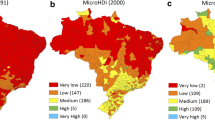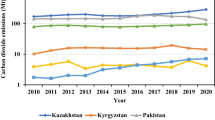Abstract
There is much discussion within the sustainable development community regarding climate stabilization and particularly, finding environmentally equitable ways to address emission reductions. Knowing the current level of emission is only one variable in this complex picture. While the rate of emissions is clearly a problem, the overall increase in GHG concentration in the atmosphere is ultimately the main driver of anthropogenic warming. Therefore, it is also important to understand the cumulative emissions, those which have taken us to the current condition. This research presents a case study of six countries to compare the emissions per capita and cumulative emissions during the past 200 years. It is known that carbon emissions are closely related to economic activities, but here we show that some countries have reached per capita emissions plateaus at different levels while others are still rising. Specifically, one approach toward socioeconomic development, in terms of energy–economy, reaches a plateau at 10 Mt carbon per person, which the United Kingdom and South Korea have attained. The US occupies another emission regime at 20 Mt carbon per person. Developing economies such as India and China are considerably below these levels, and unless they follow other integrated economic/environmental solutions, they will continue to increase their per capita emissions during development.









Similar content being viewed by others
Notes
Development classifications are standardized in this text using the World Bank income classification index.
Several small countries with low population sizes and disproportionately higher emissions rates have higher per capita emissions than the United States: United Arab Emirates, Trinidad and Tobago, Qatar, Netherlands Antilles, Luxembourg, Kuwait, Bahrain, and Aruba.
References
Anoruo, E., Ramchander, S., & Thiewes, H. (2003). Cross-border linkages among Asian closed-end funds. Journal of Economics and Finance, 27, 357–372.
Bastianoni, S. P., Federico, M. P., & Tiezzi, E. (2004). The problem of assigning responsibility for greenhouse gas emissions. Ecological Economics, 49(3), 253–257.
Central Intelligence Agency (CIA). (2010). The World Factbook. UK.
Cole, H. L., & Ohanian, L. E. (2007). The great UK depression: A puzzle and a possible resolution. In T. J. Kehoe & E. C. Prescott (Eds.), Great depressions of the twentieth century (pp. 59–84). Minneapolis: Federal Reserve Bank of Minneapolis.
Conte, C., & Karr, A. R. (2011). The US economy: A brief history. Washington: GPO for the Library of Congress.
Gapminder. (2010). www.gapminder.org.
Heitzman, J., & Worden, R. L. (Eds.). (1995). India: A country study. Washington: GPO for the Library of Congress.
Intergovernmental Panel on Climate Change (IPCC). (2007). Climate change 2007: Mitigation of climate change, contribution of working group III to the fourth assessment report of the intergovernmental panel on climate change. In B. Metz, O. R. Davidson, P. R. Bosch, R. Dave, & L. A. Meyer (Eds.), Cambridge, United Kingdom and New York, NY, USA: Cambridge University Press.
International Monetary Fund (IMF). (2009). Emerging and developing economies list. World Economic Outlook Database.
Kathuria, V. (2008). Public disclosures: Using information to reduce pollution in developing countries. Environment, Development and Sustainability, 11(5), 955–970.
Lai, D. (2000). Temporal analysis of human development indicators: Principal component approach. Social Indicators Research, 51, 331–366.
Lenzen, M., Murray, J., Sack, F., & Wiedmann, T. (2007). Shared producer and consumer responsibility theory and practice. Ecological Economics, 61, 27–42.
LePoer, B. L. (Ed.). (1987). Thailand: A country study. Washington: GPO for the Library of Congress.
Li, W., & Yeng, D. T. (2005). The great leap forward: Anatomy of a central planning disaster. Journal of Political Economy, 113, 840–877.
Nath, P. K., & Behera, B. (2011). A critical review of impact of and adaptation to climate change in developed and developing economies. Environment, Development and Sustainability, 13, 141–162.
Savada, A. M., & Shaw, W. (Eds.). (1990). South Korea: A country study, the economy. Washington: GPO for the Library of Congress.
United Nations Framework Convention on Climate Change (UNFCC). (2010). Report of the Conference of the Parties serving as the meeting of the Parties to the Kyoto Protocol on its fifth session, held in Copenhagen from 7 to 19 December 2009. Geneva: United Nations Office at Geneva.
United Nations Framework Convention on Climate Change. (UNFCC). (2010). UN climate change conference in Cancún delivers balanced package of decisions, restores faith in multilateral process. Press Releases. United Nations, New York.
United Nations, Information Services. (2000). Secretary-general Kofi Annan’s address to the Tenth United Nations Conference on Trade and Development (“UNCTAD X”). Bangkok.
United Nations Statistics Division. (2010). Composition of macro geographical (continental) regions, geographical sub-regions, and selected economic and other groupings. New York: United Nations.
Usher, A. P. (1920). Introduction to the industrial history of England (pp. 247–275). Cambridge: The Riverside Press.
US State Dept. (2010). State Department Country Background Notes.
Worden, R. L., et al. (Eds.). (1987). China: A country study. Washington: GPO for the Library of Congress.
World Bank. (2008). World development indicators online. Industry, Contribution to Economy.
World Bank. (2008).World Development Indicators Online. Exports of goods and services.
World Bank. (2008).World Development Indicators Online. Industry, value added.
World Trade Organization. (2010). Press Releases. International Trade Statistics.
Wu, Y. (2000). Is China’s economic growth sustainable? A productivity analysis. China Economic Review, 11, 278–296.
Author information
Authors and Affiliations
Corresponding author
Additional information
Readers should send their comments on this article to BhaskarNath@aol.com within 3 months of publication of this issue.
Rights and permissions
About this article
Cite this article
Cutlip, L., Fath, B.D. Relationship between carbon emissions and economic development: case study of six countries. Environ Dev Sustain 14, 433–453 (2012). https://doi.org/10.1007/s10668-011-9328-2
Received:
Accepted:
Published:
Issue Date:
DOI: https://doi.org/10.1007/s10668-011-9328-2




